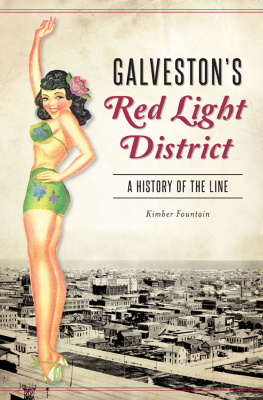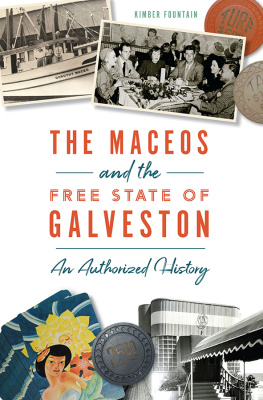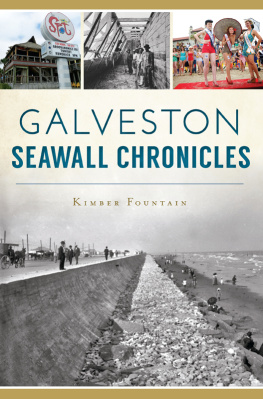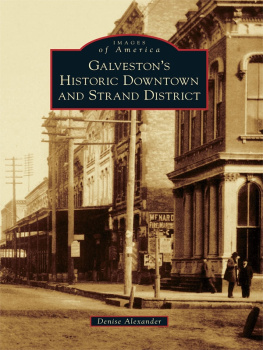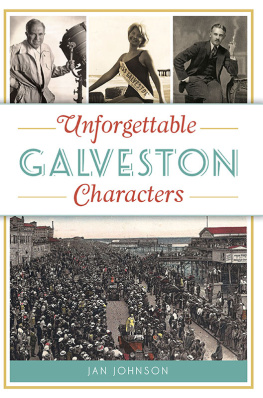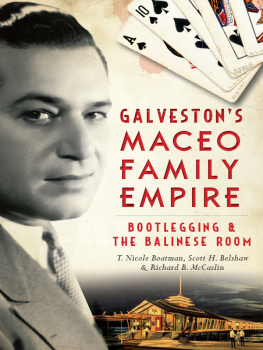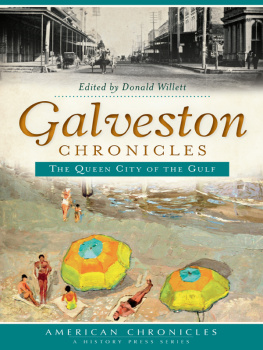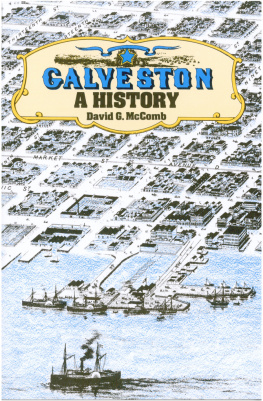

Published by The History Press
Charleston, SC
www.historypress.com
Copyright 2018 by Kimber Fountain
All rights reserved
Front cover, background: authors personal collection: foreground: authors personal collection.
First published 2018
e-book edition 2018
ISBN 978.1.43966.492.6
Library of Congress Control Number: 2018940087
print edition ISBN 978.1.46713.883.3
Notice: The information in this book is true and complete to the best of our knowledge. It is offered without guarantee on the part of the author or The History Press. The author and The History Press disclaim all liability in connection with the use of this book.
All rights reserved. No part of this book may be reproduced or transmitted in any form whatsoever without prior written permission from the publisher except in the case of brief quotations embodied in critical articles and reviews.
For my dad
CONTENTS
ACKNOWLEDGEMENTS
While writing Galvestons Red Light District, the words that Galvestons first elected female official, Ruth Kempner, said to a prominent madam often echoed through my mind, But for the grace of God I would be in your house. In my case, that grace came in the form of my dad. Although he would never admit it, my dad is one of the biggest champions of equality that I know. The father of three daughters, he never once even hinted at the notion that my being female was a weakness. Because of this, my most valued possessions have always been my freedom and my independence, which, interestingly enough, were the same driving forces behind every woman who worked the Line. My dad never questioned that about me, he never told me I needed to settle down, but what he did do was offer guidance that enabled me to productively channel this innate, rebellious desire to make my own rules and live the life I imagined.
John Hall, publisher of Galveston Monthly magazine, is truly one of the most talented people I know, and I consider working for him not only a pleasure but also an honor. I often tell readers of Galveston Monthly that we bleed into those pages, and sometimes it really does feel that way. He is the only person I know who loves Galveston more than I do, and his unceasing ability to conjure ideas never ceases to amaze me. His creativity, along with his constant support, have been two of the most influential factors in my career as a writer, and for that I am eternally grateful.
A special thank-you to Tena and Louie Jerger of the Island Guide for being the first to take a chance on an unpublished writer, and to The History Press, which did the same for an unpublished author.
To the wonderful staff at the Galveston and Texas History Center of the Rosenberg Library, especially Sean McConnell, for their generous assistance with my research.
To Scott Field and my other sources who preferred to stay anonymous, for lending me morsels of rare insight into an obscure part of Galveston history that were small but crucial to this story.
To Scotty Hanson, owner of Antique Warehouse at Twenty-Fifth Street and Postoffice. Three years ago, when I first wrote about the district for the magazine, Scotty was kind enough to regale me with a mountain of information about his building and the district, much of which I also used in this book.
Personally, I also owe an enormous amount of gratitude to my mom. She is not only the best mom I could have asked for, but she also bestowed upon me her love of grammar, reading and writing; she graciously gave of her English professor skills to edit my manuscript.
And to Eric, whose support of me is unending. I love you to the moon and back.
Lastly, I am fully convinced of the fact that we humans would be nothing without our dogs. Thus, I must acknowledge my sweet pea Elle; every day I strive to be the person that she thinks I am.
INTRODUCTION
I have always been one to root for the underdog, and if ever an underdog existed, it was a prostitute working the Line during the City of Galvestons torrid love affair with vice. She was the best kind of underdog, toothe kind that did not even know she was one. Most of these ladies were just doing what they had to do to survive or get ahead, and they felt lucky enough to be in a place that let them do it. To the select few who were not doing it out of necessity, it was likely more of a rebellious manifesto that proclaimed their own individual freedom than it was to be a symbol of midcentury activism. But whatever their reasons, these were women who valued their independence even more than they valued their dignity or place in society, and certainly more than an arbitrary moral code. These were women who saw themselves mired in a societal system that stacked the odds against them, giving them no other choice; they made that choice and made the best of it. These were women who I wanted to know.
Thus it became clear to me when assembling the structure of this book that I could not approach it like I have approached nearly every other piece of history I have written: chronologically. This format is certainly acceptable and useful, as recounting events, people and places in the order that they existed seems only natural. However, I knew that this work was an attempt to glean insight and garner understanding for a certain kind of woman who is often given no regard, as well as to ferret out the societal implications of her existence, and so I thought it wiser to fully establish the communal and economic environment in which she was immersed before presenting a case for her cultural vindication.
This structure also helped settle a minor internal conflict within myself that arises now and again in my work. I love history, and I love writing about it. Learning about how life used to be for the people who came before and tracing the steps of societal evolution are fascinating to me. However, I also hold a personal philosophy that the past is ultimately irrelevant, along the same lines of the gurus who teach the past is in the past, let go and your past doesnt define you. Thus, if I am to maintain that rehashing an individuals past is pointless, I must certainly find a very good reason for regurgitating the collectives.
Sometimes, my reason is simply to tell a story that has never been told or to recognize certain people whose contributions would otherwise be buried in the sands of time. Other times, I want to find the beauty and meaning in places where there was previously thought to be none, and I almost always seek to celebrate my subjects. With this particular subject, it was all of that and more.
I do not quite remember when I first learned of Galvestons red-light district, but I know that the moment I did was the moment I became enamored with the idea of it. I had been previously fascinated by stories of courtesans in Renaissance Italy, wonderfully portrayed in the 1997 movie Dangerous Beauty starring Catherine McCormack, and of course I, like every other person in the country, have seen Pretty Woman more times than I can count. When I found myself wanting to write a book about the topic, I could not help but wonder why it captivated me so much and why it did the same for most of the population. Why is prostitution an acceptable facet of mainstream pop culture, an appropriate scenario for a kitschy rom-com, yet the reality of it is feared and scorned to the point of inspiring movements against it? Is it illegal because it is immoral? Or is it illegal because the basis of it is completely misunderstood?
Next page
